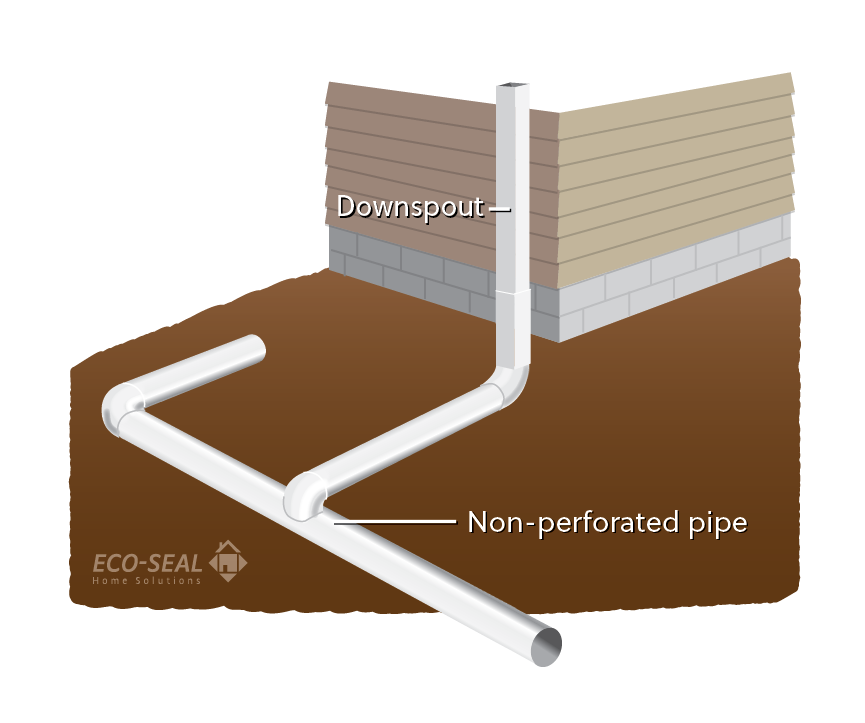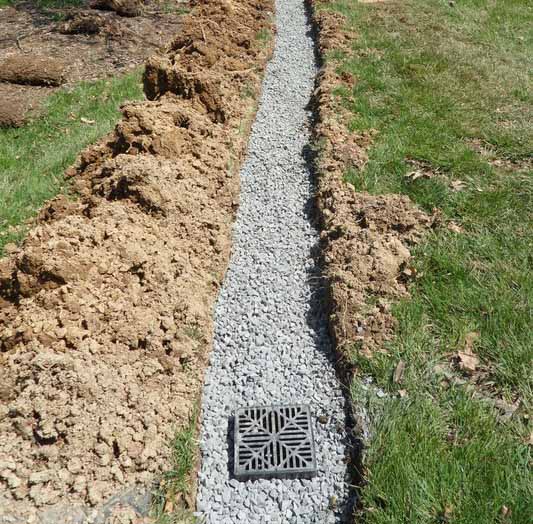How to build an exterior French drain system
What is a French Drain?
A plastic drain pipe in a gravel-filled trench that removes excess ground water.



Parts of a French drain system
- A trench at least 12 inches wide and 18 to 24 inches deep; larger trenches provide better drainage and last longer, but require more work.
- 4-inch-diameter perforated plastic drain pipe to collect excess water
- Washed drainage gravel (figure the amount needed with a gravel calculator)
- Water-permeable landscape fabric to prevent silt and roots from entering the drain pipe
Tip: I always use rigid 4” drain pipe and not the corrugated drain pipe. Rigid pipe is more expensive but I have replaced far too many corrugated systems that have failed because the pipe is crushed or the pipe dips down because of its flexibility hampering the flow of water downhill.
Things to consider before digging starts:
- Design the system – Get the lay of
land , specifically where are the low areas that are constantly wet and most importantly where is an area that is lower than the wet areas where you can daylight your drain system and deposit the water you are removing. - Call the utility marking hotline before you dig. By dialing 811, you can tap free city services that can mark the location of all underground utilities before you start digging. You can find additional information on digging services at Dig Safe. These services generally will not mark utilities that you have installed for your projects. For instance, if you installed a light on a pole and ran the electrical wire underground, this will not be marked. If you ran a gas line to an exterior fire pit, this will not be marked. A
ccess the property yourself to make sure all utility lines are marked. - Plan for dirt. You’ll be excavating a large amount of dirt and replacing it with drainage gravel, so you’ll need to figure out where to put your dirt. Suggestions: fill in low spots; create raised beds; build up foundation slope.
Options for excavating your French drain trench include:
- Dig by hand. It’s labor-intensive but cheap if you do it yourself (enlist a friend or two).
- Rent a trenching tool. A gas-powered, walk-behind trenching tool will cut a trench up to 18 inches deep and 24 inches wide. Cost: $125 to $200 per day. (You’ll need a way to get the tool back and forth to your property.)
- Tip: A trenching tool throws dirt off to the side. Lay pieces of old plywood or a heavy tarp alongside your trench location to catch dirt and make it easier to move it to another location.
- Hire a professional backhoe operator. A backhoe can cut a deep, wide trench quickly, but you’ll need to plan how to get this big, heavy tool into your yard. Including an hourly rate for the operator, travel time to haul the backhoe to your property, and the rental cost of the machine, expect to pay $300 to $1,500. Also, the backhoe will tear up the existing turf. So figure in extra time to prep the area for new turf and the cost of the replacement turf.
How to Install a French Drain
- Call the 811 hotline to have underground utilities marked.
- Dig the trench system. (see above)
- Line the trench with landscape fabric. The fabric should be wide enough to extend 1 foot past the tops of the trench walls on both sides. The excess fabric is to be folded over the top after the last layer of gravel is placed on top of the pipe. Temporarily pin the excess in place with nails or landscape fabric pins.
- Add 2 to 3 inches of gravel to the bottom of the trench.
- Lay the drain pipe in the trench, with the drain holes facing down.
- Install fabric around your pipe to prevent rocks from entering the pipe and to help prevent clogging of the drain holes. There is fabric called a sock that fits perfectly around the pipe and is easily pulled over the pipe during pipe installation.
- Cover the drain pipe with gravel to within 2 to 3 inches of the top of the trench.
- Fold the excess landscape fabric over the top of the gravel.
- Fill the top of the trench with soil and lay your grass. TIP: When digging your trench, first cut your grass into medium size blocks to be reused on top of the trench.
Other Things to consider
- Your gutter downspouts can be tied into your system using pipe fiitings like Y’s and T’s. If additional items like downspouts and drain boxes are added to your French drain system the outlet pipe used to route the water to the daylight exit may need to be sized up to a 6” pipe to allow for the additional water entering the system.
- Generally, the pipe that extends from the French drain to the spot where the drain is day lighted needs to be solid drain pipe and not corrugated.
- I do not like what are called pop-up emitters. These emitters are installed at the end of the drain system at the end of the pipe for the purpose of day lighting. However, these emitters usually get stuck in place and do not pop up virtually voiding the drain system.
